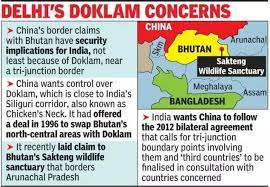India ‘Takes Note’ As China, Bhutan Ink Border Talks MOU
Oct 15, 2021
India takes note of boundary pact between China & Bhutan
NEW DELHI: Bhutan and China signed an MOU on Thursday for what they called a “Three-step ” for expediting the Bhutan-China boundary negotiations and which according to will provide fresh impetus to talks and can bring the negotiations to a successful conclusion acceptable to both sides.
The MoU comes at a time India’s own talks with China to resolve the military standoff in eastern Ladakh remain inconclusive.
Like India, Bhutan remains locked in a boundary dispute with China and while the two have held 24 rounds of border talks since 1984, the last time they held these boundary negotiations was in 2016, or before the Doklam dispute involving India in 2017.
India closely follows all boundary engagements between Bhutan and China as Chinese claims over disputed territories have serious security implications for New Delhi. The MEA was extremely cautious in reacting to the development as it said the government had noted the signing of the agreement.
““We have noted the signing of the MoU between Bhutan and China. You are aware that Bhutan and China have been holding boundary negotiations since 1984. Similarly, India has been holding boundary negotiations with China,” said MEA spokesperson , when asked about whether or not Bhutan had kept India informed about the MoU.

For many, and going by past behaviour, it’s inconceivable that Bhutan would not have discussed an MoU on the boundary issue without explaining at least the broad contours to Indian authorities. Bhutan has so far not accepted the Chinese 1996 “package deal’’ that offered to exchange territory in central Bhutan for Doklam, located dangerously close to India’s Siliguri Corridor. China reiterated this land swap offer last year.
The 2017 Doklam standoff further complicated the border issue as India saw ’s construction of a road in the Doklam area as a violation of the 2012 bilateral agreement that tri-junction boundary points between India, China and third countries will be finalised in consultation with the concerned countries.
China settled the boundary with Russia with a formal agreement in 2008 and has reached agreements in some other cases, but remains embroiled in maritime disputes with Japan and several ASEAN nations.
The text of the MoU, which was signed during a virtual ceremony, has not yet been made public. Bhutan said in its announcement that during the 10th expert group meeting with China in April this year, the sides had agreed on the roadmap that will apparently build on the 1988 Guiding Principles for the settlement of the boundary and expedite negotiations. In the media then, it was reported that Bhutan and China had discussed a three-step roadmap.
A month later, there were reports that Bhutan had reservations about the roadmap, one of which related to China’s claim over the wildlife sanctuary in eastern Bhutan (close to the Arunachal border), and that Bhutan had suggested certain amendments. It’s not clear yet to what extent China has taken into account those amendments. Bhutan said the roadmap will provide fresh impetus to the boundary talks and that it expects that the implementation of this roadmap “in a spirit of goodwill, understanding and accommodation’’ will bring the boundary negotiations to a successful conclusion that isacceptable to both sides.
Courtesy: TOI

